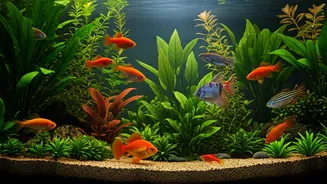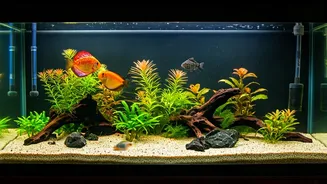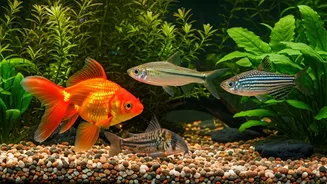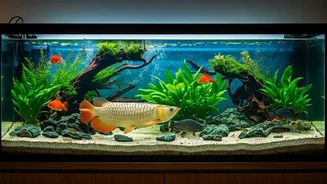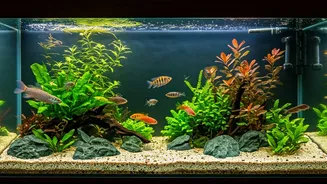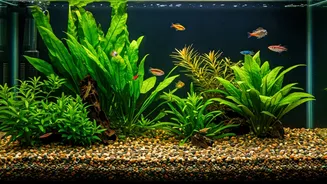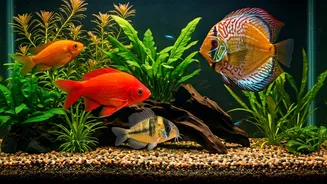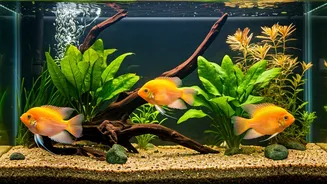Introduction to Aquariums
Setting up a home aquarium can be a rewarding experience. It is important to know that before introducing any fish, a tank needs to go through a cycling
process to establish beneficial bacteria that will break down harmful waste. This cycle usually takes several weeks. Selecting the right fish is vital for success, so consider factors like compatibility, size, and care requirements. Overcrowding can stress fish, so start with a manageable number, and research each species' needs before acquiring them. Maintaining water quality is paramount; this requires regular testing and partial water changes. Proper filtration, heating, and lighting also contribute to a healthy environment. By understanding these basics, you can create a beautiful and thriving aquarium, bringing joy and a sense of wonder to your home.
Guppy: The Colorful Charmer
Guppies are a fantastic choice for beginners due to their hardiness and vibrant colors. They are livebearers, meaning they give birth to live young, adding an exciting element to fishkeeping. Guppies thrive in well-maintained tanks with stable water conditions and a temperature range between 72-82°F (22-28°C). A 10-gallon tank can comfortably house a small group. Feed them a varied diet of flakes, pellets, and occasional treats like brine shrimp or bloodworms. Regular partial water changes are essential. Guppies are generally peaceful and can coexist with other small, non-aggressive fish. Their prolific breeding habits mean you may soon have a tank full of these delightful little fish, which brings an exciting aspect for beginner aquarium keepers, allowing them to experience the life cycle first hand.
Betta: The Stunning Siamese
Betta splendens, commonly known as the Siamese fighting fish, is a popular choice for their striking beauty and relatively simple care requirements. They are best kept alone in a tank of at least 5 gallons, as males will fight each other. They prefer a temperature range of 78-82°F (25-28°C) and require a heater and a filter. Betta fish are labyrinth fish, meaning they can breathe air at the surface, which is why a lid is essential to prevent them from jumping out. They thrive on a diet of betta-specific pellets, supplemented with occasional treats like bloodworms or daphnia. Provide a calm environment with plants or decorations for them to explore. Regular water changes are critical to maintaining their health. Although solitary, Betta fish are a stunning addition to any home and can bring both relaxation and beauty.
Neon Tetra: Shimmering Community Fish
Neon tetras are small, peaceful fish known for their bright neon stripe. They are ideal for community tanks, thriving in groups of six or more. A 10-gallon tank is the minimum size for a small school. They prefer slightly acidic water with a temperature between 72-78°F (22-26°C). Provide a well-filtered tank with plants and hiding places. Feed them small flakes or pellets, supplementing with occasional treats like brine shrimp or daphnia. These fish are relatively easy to care for but are sensitive to sudden changes in water parameters. Introduce them slowly and observe for signs of stress. Neon tetras create a mesmerizing spectacle in an aquarium, adding a touch of elegance to any setup. With proper care, they are an excellent option for beginners looking to start a community tank.
Platy: Hardy and Playful
Platies are another excellent choice for beginners due to their hardiness and variety of colors and patterns. Like guppies, they are livebearers. They thrive in a wide range of water conditions, making them very adaptable. A 10-gallon tank is suitable for a small group, and they enjoy a temperature range of 70-80°F (21-27°C). Provide them with a varied diet of flakes, pellets, and occasional vegetable-based foods. They are generally peaceful and can coexist with other peaceful community fish. Platies are prolific breeders, and keeping them in a well-managed tank can be an enjoyable learning experience. Regular water changes and a balanced diet are key to their health and vibrant colors, making them a fantastic addition to any beginner’s aquarium.
Corydoras: The Bottom Dweller
Corydoras catfish, or Corys, are peaceful, bottom-dwelling fish that are great for keeping a tank clean. There are many different species to choose from, with varying sizes and colors. They need a soft substrate, such as sand, to protect their barbels. Keep them in groups of at least three or more, as they are social creatures. A 10-gallon tank is sufficient for a small group, and they prefer a temperature range of 72-82°F (22-28°C). They will consume leftover food, which helps maintain the tank. They are generally peaceful and can coexist with other community fish. Corydoras are fascinating to watch as they sift through the substrate, seeking food. Regular water changes and a healthy diet are critical to their well-being, making them a valuable and interesting addition to any aquarium.
Molly: The Versatile Livebearer
Mollies are another popular livebearer that comes in various colors and fin shapes. They prefer a slightly brackish environment, making them unique, but they can also thrive in freshwater tanks. A 20-gallon tank is generally recommended for a group of mollies. Provide them with a temperature range between 72-82°F (22-28°C) and a varied diet including flake food and algae. They are relatively hardy, but be aware of their breeding habits, as they can quickly populate a tank. Mollies are peaceful and can coexist with other community fish, making them a popular choice for beginners. Their diverse appearance and easygoing nature make them a fun addition to any aquarium, providing plenty of activity and color.
Goldfish: The Classic Choice
Goldfish, a classic choice for many, require more space than some other beginner fish, but they offer a timeless appeal. They produce a lot of waste and can quickly pollute a tank. For a common goldfish, a minimum of 20 gallons is recommended, with larger tanks being preferable. They thrive in cooler temperatures, between 65-72°F (18-22°C), and need a well-filtered tank with regular water changes. They are omnivores and need a balanced diet. Goldfish are generally peaceful but should not be kept with smaller fish. Be cautious of overfeeding, which can lead to health issues. With proper care and a spacious tank, goldfish can live for many years, offering a rewarding experience for any beginner interested in keeping a larger aquatic pet.
Kuhli Loach: The Eel-Like Cleaner
Kuhli loaches are fascinating, eel-like fish that are great for a tank’s ecosystem. They are bottom dwellers and prefer to hide. They need a soft substrate. They are peaceful and should be kept in groups. A 10-gallon tank can house a small group. They prefer a temperature range of 73-82°F (23-28°C). They are scavengers and will consume leftover food. Provide them with hiding places and a varied diet. These loaches add an interesting dynamic to the tank, contributing to the overall beauty and function. With the right conditions, Kuhli Loaches will bring an element of intrigue and add value to any aquarium setup, making the process of aquarium keeping exciting.
Cherry Shrimp: The Algae Eaters
Cherry shrimp are an excellent addition to beginner tanks, especially if you want to control algae growth. They are small, colorful invertebrates that are relatively easy to care for. They thrive in a well-established, planted tank with stable water parameters. A 5-gallon tank is sufficient for a small colony. They prefer a temperature range of 65-80°F (18-27°C). Provide them with hiding places and algae wafers or other shrimp-specific foods. Cherry shrimp can breed quickly in ideal conditions, adding a dynamic and exciting aspect to the aquarium. They are peaceful and do not bother other inhabitants, making them suitable for community tanks. They play a vital role in helping maintain the aquarium's overall health and aesthetic appeal.
